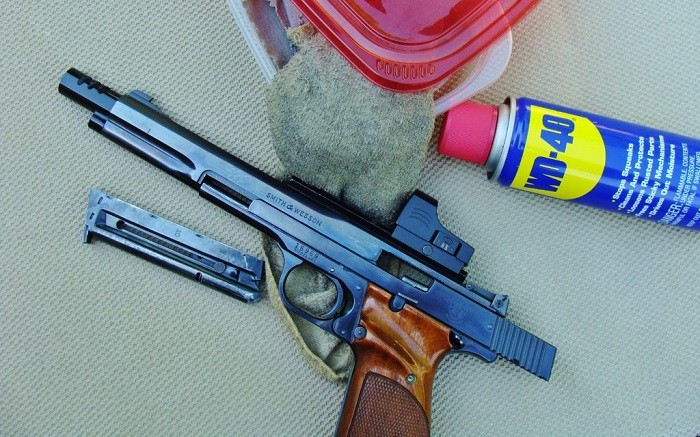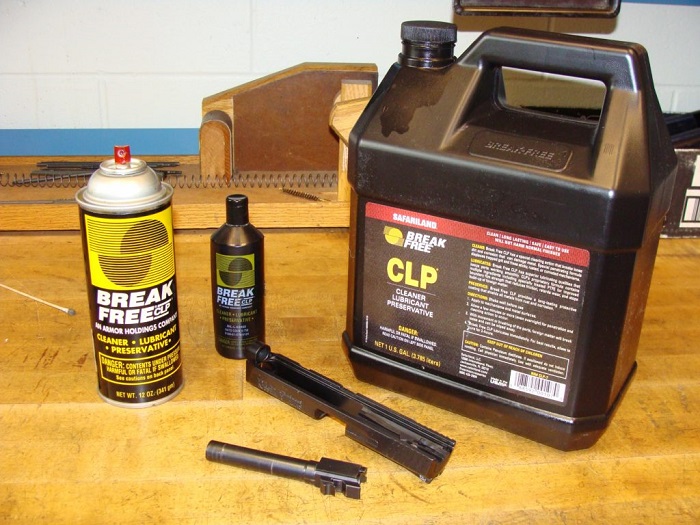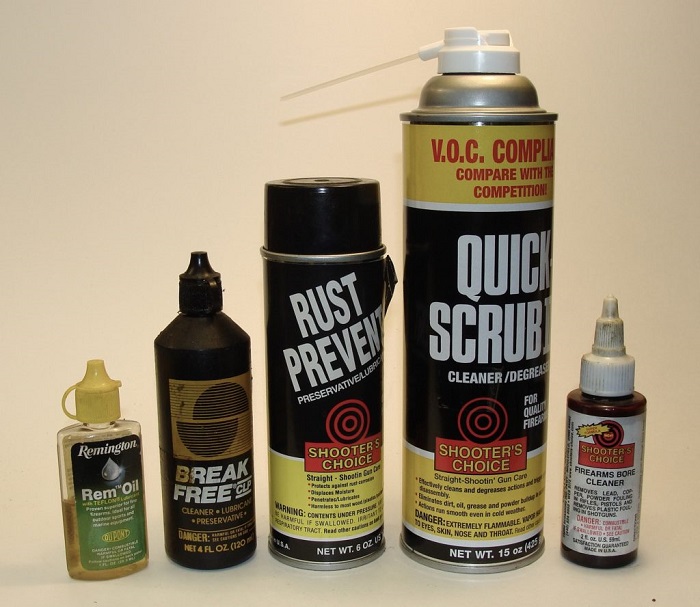The use of WD-40 to clean or lube guns has been hotly debated since… well, probably since the invention of WD-40 itself back in 1953. There are some who swear it’s a bad idea while there are others that say it works quite fine. The reality, from my experience, is that it’s both good and bad, depending on the exact use.
by Steve Markwith, author of Survival Guns

That said, while attending a state-sponsored firearms instructor update, the subject of gun cleaning came up. The guest speaker (who I held in high regard) declared he’d rather pee on his personal firearms than use WD-40. Near as I can deduce, this opinion is shared by some others (perhaps, using less extreme alternatives). I want to address that, but first…
A Brief History of WD-40
According to the official WD-40 website:
In 1953, in a small lab in San Diego, California, the fledgling Rocket Chemical Company and its staff of three set out to create a line of rust-prevention solvents and degreasers for use in the aerospace industry. It took them 40 attempts to get their water displacing formula to work, but on the 40th attempt, they got it right in a big way. WD-40 was born. WD-40 stands for Water Displacement, 40th formula. That’s the name straight out of the lab book used by the chemist who developed the product.
Their detailed history goes on to say that the first company to use the product was Convair to protect the Atlas Missile from rust and corrosion. Use of the product accelerated quickly form there. By 1993, WD-40 could be found in 4 out of 5 American households.
Man Overboard with a Shotgun in Salt Water
Now, going back to the comment from the speaker at the firearms training. His comment caused me to recall an incident from years past.
One cold December morning back in the early 1970s, while chasing sea ducks with a buddy in a canoe off Cape Cod, the wind suddenly came up. We paddled toward the security of a nearby island, but managed to flip 180 degrees in the surf while attempting to beach the canoe. For a brief period, we wound up completely underwater, but somehow, we were able to make it to shore, still clutching our shotguns.
I immediately began stripping off clothing in hopes of finding a layer dry enough to wipe the salt water off m 12-gauge Beretta over & under. Miraculously, one small part of my undershirt survived the plunge! So, despite the cold, it came off for a hasty wipe-down.
Meanwhile, the canoe had washed onto the beach, upright again, with the paddles floating nearby. We waded in and retrieved them, but waves continued pouring into the canoe rendering it impossible to move. Eventually, through a combination of frantic paddling and the outgoing tide, we were able to bail out enough water to drag it clear of the surf and pour out the remaining water. From there, a quarter-mile portage across the island put us in calmer seas for a hypothermic voyage to safety.
WD-40 to the Shotgun Rescue
Upon returning home, I filled the bathtub with fresh water and immersed the entire gun, vigorously swishing it back and forth in hopes of flushing out any remaining brine. Next, after drying it as best I could, I power-nuked the whole shotgun with a can of WD-40 that happened to be on hand.
For days afterward, I checked the gun everywhere for rust and was quite surprised to see none. Mission accomplished – or so I thought until the following fall. After experiencing a misfire on an overhead crossing goose, more began to occur – but, only during high-angle shots.
After much head-scratching, the cause was finally revealed. The small spring that returned the cocking bar eventually corroded and snapped. The bar, a sliding plate in the bottom of the receiver, drives the internal hammers rearward as the gun is opened. When the action is closed, the spring shoves it forward again. But, lacking spring tension, during overhead shots, the bar maintained contact with the hammers, slowing their impact-force.
Suppressor Alternatives – No Noise or $200 Stamp
Installation of a new spring restored order while providing a great opportunity to thoroughly examine the Beretta’s internals. Other than the spring, WD-40 had done its job, possibly because of that “water displacement” attribute. I suspect urine would not have been as effective.
How I use WD-40 on Guns
More than four decades later, I’m still using WD-40 on guns; but NOT as described above! Like prune juice, the guiding principle is moderation! Nowadays, I only use it to wipe down firearms after handling them.
For nearly thirty years, on top of my gun safe, a Tupperware container contained an old face cloth misted with WD-40. Occasionally, I’d give it a fresh shot or two, but never enough so it was dripping wet. The right amount was just enough to apply a light film to metal surfaces before a gun was returned to the safe.
The cloth eventually became so threadbare that I cashed it in for a replacement, which now resides in a plastic lunch meat container. That’s the extent of my technical advancement regarding maintenance of steel surfaces. As for the conditions of the guns, most have seen steady use between work or outdoor adventures, sometimes in miserable conditions. Beyond their inevitable handling dings, you won’t find a speck of rust.
A Fix For Extreme Conditions
In my household, hunting is a tradition. While others are more wisely sitting out bad weather, we are out in the woods. But a warm house sure does feels great after a cold, soggy day in late November! That’s when a stainless bolt-action rifle with a synthetic stock can make life easier. It’s simple enough to remove the bolt and nylon sling so they can be placed in a warm spot to dry (beside the wood stove for us).
8 Problems with Single Point Slings on AR-15s
Next, the rifle can be laid upside down across the arms of a chair with its muzzle oriented slightly downward. Finally, off comes the wet clothing. After a hot deer stew supper, if needed, any residual water droplets can be blown out of the action, barrel-channel, and bolt through cautious use of a hairdryer. The surfaces might also receive a very light misting of WD-40 (or Rust Prevent, etc.), and the bore may receive a patch or two.
In our region, remote deer camps are a big part of hunting, so even minus a hairdryer, such stop-gap solutions help. Actually, we own some traditional blued/walnut household firearms that have survived the same regimen quite well.
Stay Mindful of Gun Cases
Because the linings of gun cases can absorb moisture, they’re not ideal for long-term storage of firearms. However, I have occasionally misted their soft-case linings with WD-40 to help ward off rust. One caveat – given enough time, spare ammo in elastic stock carriers, etc. could eventually become unreliable.
Is Using WD-40 on Guns a Bad Idea?
I think it depends on the exact use. There have been instances where good people perished due to defensive ammunition that failed to fire because of contamination from solvents. It may be tempting to hose down a handgun with something like WD-40 after hours spent in pouring rain, but this “shortcut” could prove fatal. That’s why I don’t spray it directly into actions.
Bore Cleaning
A few times, on the fly, I’ve tried using WD-40 to clean shotgun barrels, but invariably, the result was a gloppy mess that took twice the effort to remedy. In a pinch, it’ll rescue a bore exposed to water.
Lubrication and Residual Effects
If you slather on WD-40, a gummy residue will accumulate, which could impede function while trapping dirt or sand. Eventually, it’ll harden into a varnish-like coating, causing problems in tight-tolerance spots. Inside a firing pin channel, misfires could develop. Wood stocks will also soak up oils and the long-term effect will be softening. The stock heads of many old side-by-side shotguns are dark and punky for this reason, exacerbated by vertical storage.
Thus, I don’t use WD-40 for lubrication. There are much better products for metal-on-metal surfaces like slide-rails, bolt lugs, or shotgun hinges. For me, WD-40 just serves as an easy wipe-down fix, using the low-tech container atop the safe.
Alternative Lubricants
Just about all firearm functions involve at least some metal-on-metal contact, so proper lubrication is the key to longevity and reliability. Environmental factors can also raise concerns, especially in other than “normal” conditions. While total absence of lubrication is almost universally bad, too much can raise havoc. The challenge can be to find a suitable balance.
Desert operations can dictate sparing use of lubricants, combined with non-stop firearm maintenance. Coastal areas with salty sea air or places seeing heavy rain can require the opposite (still with frequent maintenance). That said, we’ve watched a few cold weather military sessions come to a screeching halt on our range due to improper lubrication. Grease can stiffen up in cold weather, and so can some oils.
The Break-Free Alternative
We’ve had no such issues with military Break-Free CLP in all sorts of weather during large-scale range operations. CLP stands for “cleaner, lubricant, preservative.” We buy it by the gallon, but a smaller 4-ounce plastic bottle is much more convenient for individual use.

A gentle squeeze will dispense individual drops to prevent flooding of critical areas like fire-control parts. If the manufacturer recommends one drop, then that’s what should be applied (as opposed to flooding from stem to stern).
Lacking a manual, I just go with a bit of common sense, applying lubricant sparingly. Using a semi-auto pistol as an example, common spots include one drop each to the corners of the frame rails, the barrel’s muzzle, its slide-locking surfaces, and the guide rod. Depending on the pistol, the disconnector and hammer strut may also get a drop.
Lubrication occurs after cleaning the field-stripped pistol, just prior to reassembly. Then the slide is run vigorously back and forth a few times, not only to detect any glitches, but also to distribute the lubricant.
The final step is a wipe-down of all exposed metal surfaces with CLP, using a lightly moistened cleaning patch. Magazines remain clean but dry to prevent the attraction of grit. This process has served us well for decades in all sorts of weather and temperature extremes.
Other Lubricants
We also use copious amounts of Shooter’s Choice for bore cleaning. It works well across the board and even cuts plastic wad residue. But, since technology moves quickly, I queried a trusted armorer who’s tried several newer alternatives. Here’s his take:
I like M-Pro 7 Gun Cleaner, M-Pro7 Gun Oil, and Qmaxx BLU premium gun and knife lube. I also use Qmaxx Black Diamond for pistol slides, AR-15 bolts, and gas-operated shotguns because it works well. One other thing I use a lot is Frog Lube Paste for slide rails (also AR-15 triggers) because it stays put, and works under heat.
He closed with this: “I know you were trying to keep this simple, but is anything in Gun Land simple?” How true!

WD-40 and Use on Guns Summary
So why use WD-40 at all? Well, mostly, I use the stuff because several cans are always on hand to spritz ATVs, boats, fishing gear, outdoor power equipment, tools, etc. Also, it smells better than many firearm-specific products, which keeps The Better Half a whole lot happier (using the above wipe-down technique, it’s just about odorless).
Others looking for a simple but more firearms-friendly alternative could do worse than Break-Free CLP. Several years ago I read about a comprehensive test involving nails exposed to salt water. Beyond higher-tech lubes, WD-40 and Break-Free were tried. As I recall, although Break-Free didn’t take first place, it did perform surprisingly well – one reason the military uses it.
Do you use WD-40 on your firearms?

6 comments
I’ve been using wd 40 as a gun wipe for over 50 years. Yes I agree that it’s best used as a wipe mainly and my guns never have rusted. I agree it’s not for internal use. I have an old wd40 rag also I use for wipeing my guns down after handling. The blue on my BLR I bought in 1972 is gone in many places but there never has been any rust due to WD 40. In 1968 when I was in USMC boot camp our DI had us wipe our M14 rifles down before a major inspection. It was considered illegal at that time because it worked so well. Those M14s didn’t have a lick of blueing due to its extreme use over the years of abuse and would rust very quickly in that San Diego climate.
I spent 16 months in Iraq 03-04. The M-16’s that we had would not fire very well at all in the dust and sand. You would have to strip and clean it everyday to prevent jamming. We did not have the time to do this daily because of the high tempo of our mission. A fire fight was common place during this time. An exchange of rounds was very common. One late night the convoy I was in got hit with small arms fire from multiply fronts. I started returning fire and my weapon kept jamming up. I would have to clear the jam and use the forward assist to load a round to fire and it would only jam again. I had not clean my weapon properly in a couple days. I was fortunate that the crew serve weapons did not suffer the same fate as my rifle. So I wrote home to my family and asked for something to clean my weapon with. A few weeks later I received a can of WD-40. It was an immediate success. I would spray it into the breach before a mission and when it was time to return fire I never had another jam at all. Soon my entire squad carried a small can with them every where that we went. I’m a true believer in the value of a can of WD-40 in all aspects of weapon care.
I hope you are right, I upset a canoe getting out, (you know, with the bow up on land), and dunked my BLR in the loon shit muskeg.
It froze overnight, (I fortunately had a spare rifle,)
I sprayed it with WD40, as I had to do something to dry it out inside, and it is near impossible for a mere mortal to take a BLR app-art.
it’s funny, this same debate goes on in motorcycling regarding the chain drive. typically manufacturers sell a two-part cleaner and lube which is relatively expensive, and the argument is that the lube which is thick and sticky holds the dirt and dust in the chain. WD-40 will clean the chain, and most chains are o-ring so they really don’t need lube. also, one doesn’t have to spray WD-40, it’s available in 1 gallon cans at home Depot.
I have used wd40 sporadically on guns for 30 years. Other people I know have 50 years experience using it exclusively. I’ve never encountered a single problem other than gossip talk. Only minor issue was a gun I inherited. It is a mid 60s Remington 1100. It had a brown varnish all over internal and external. It was heavily applied wd40 with dust. It was fought to remove. But not a speck of corrosion anywhere. There are guns out there that are worth $10,000 plus that are pristine and have never seen a product other than wd40 or 3n1.
For me, the question is frequency-of-use. If you’re like my uncle, who had a Remington 870 he fired two times in twenty years (and only one shot per event) then WD-40 is a horrible option; it’s not a “gun oil”.
My BP guns? WD-40 is the go-to because I tend to shoot 3-6 times per month and any problems with residue tend to not have a chance to take hold. If I used a trad gun oil, my yearly shooting expenses would rise noticeably because with BP, you have to clean when you’re done shooting, it’s not negotiable.
My method is simple. My “once in a blue moon on a Thursday in a leap year” guns that might not see use in any given year? They get Ballistol. It’s expensive but it does good work and leaves no residue. My “rarely goes 7 days without use and needs to be cleaned soon after” guns? They get WD and I’ve yet to have a problem. Basically, if you actually use the gun, WD is fine. If you have it for the psychological benefit of having it, use a commercially available gun oil.
The key, for me, is that it’s not so much about what you use as how you use it. You get the can and unleash a 20 second blast on the gun, yeah, you’ll have the bad residue issues and crud. If you spray a little on a rag and a few patches, maybe have a small amount in a dispensing bottle for judicious application…WD is hard to beat.